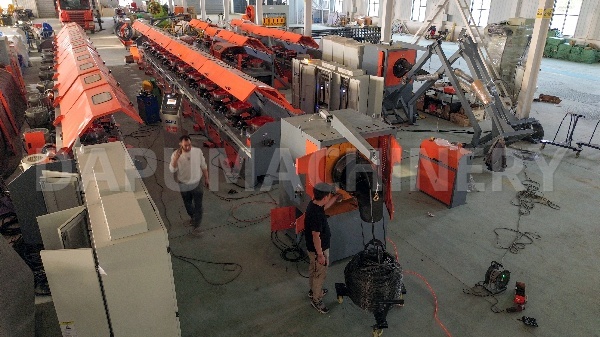
Straight Wire Drawing Machine vs Pulley Type: Which One Is Better for Your Plant?
Category:News
Author:
Source:
Add time:2025-04-30 11:30
In industries ranging from construction to automotive manufacturing, wire drawing machines are indispensable for producing high-quality metal wires. However, choosing between a straight wire drawing machine and a pulley-type (block) machine can be challenging, especially in emerging markets like South America, , where operational conditions and production needs vary widely. This article compares the two technologies, highlighting their pros, cons, and ideal use cases, with a focus on DAPU’s straight wire drawing machines, to help you decide which suits your plant best.


How They Work: Key Differences
1. Straight Wire Drawing Machine
Design: Uses a linear arrangement of motor-driven rollers to pull the wire through multiple dies in a single pass.
Process:
The wire is fed from a pay-off reel.
It passes through cleaning and lubrication systems.
A series of synchronized rollers pull the wire through progressively smaller dies.
The finished wire is coiled onto a take-up reel.
Key Feature: Tension is controlled electronically, ensuring consistent diameter and surface quality.
2. Pulley-Type (Block) Machine
Design: Relies on a series of pulleys (blocks) stacked vertically or horizontally. Each pulley rotates to pull the wire through a die.
Process:
The wire is threaded through multiple pulleys and dies.
Each pulley increases tension incrementally.
The final wire is wound onto a reel.
Key Feature: Simpler mechanical design but less precise tension control.
Straight vs Pulley-Type: 5 Critical Comparisons
1. Production Speed & Precision
Straight Machine:
Pros:
Achieves speeds up to 16m/s (e.g., DAPU LZ-560C).
Precise tension control minimizes diameter variations (±0.01mm).
Cons: Higher upfront cost.
Pulley-Type:
Pros: Lower initial investment.
Cons:
Limited speed (typically ≤10m/s).
Tension fluctuates due to pulley slippage, risking wire breakage.
Best For:
Straight machines: High-speed production of high-carbon steel wires (e.g., Saudi Arabian oil rig cables).
Pulley-type: Low-volume, low-precision tasks like aluminum handicraft wires in Indonesia.
2. Energy Efficiency
Straight Machine:
Pros:
Energy-efficient motors (e.g., DAPU LZ-560C uses 22KW vs. pulley-type’s 30KW for similar output).
Reduced friction due to optimized roller alignment.
Cons: Requires stable power supply for electronic controls.
Pulley-Type:
Pros: Mechanical operation works during brief power outages.
Cons: Higher energy waste from pulley friction and slippage.
Best For:
Straight machines: Regions with unstable grids (e.g., rural Africa) where energy savings are critical.
Pulley-type: Workshops with intermittent power but low energy costs.
3. Material Compatibility
Straight Machine:
Pros:
Handles thick, hard wires (e.g., ≤8mm high-carbon steel on DAPU LZ-600C).
Consistent performance with materials prone to cracking (e.g., steel alloys).
Cons: Less flexible for frequent material changes.
Pulley-Type:
Pros: Easier to switch dies for mixed-material production (e.g., copper and mild steel).
Cons: Struggles with high-tensile materials, causing pulley wear.
Best For:
Straight machines: Plants processing high-carbon steel or stainless steel (e.g., automotive springs in Thailand).
Pulley-type: Small workshops using soft metals (e.g., aluminum wires for Nigerian crafts).
4. Maintenance & Durability
Straight Machine:
Pros:
Modular components (e.g., DAPU’s quick-release dies) simplify repairs.
Robust construction resists dust and humidity (ideal for Middle Eastern deserts or Vietnamese monsoons).
Cons: Requires skilled technicians for electronic systems.
Pulley-Type:
Pros: Mechanical parts are easier to fix locally.
Cons: Frequent pulley and belt replacements in abrasive environments.
Best For:
Straight machines: Large factories needing minimal downtime (e.g., 24/7 steel cable plants in the UAE).
Pulley-type: Remote workshops with limited technical support.
5. Cost Considerations
| Factor | Straight Machine | Pulley-Type Machine |
|---|---|---|
| Initial Cost | Higher (e.g., DAPU LZ-560C: ~$28,000) | Lower (~20,000) |
| Operating Cost | Lower (energy-efficient motors) | Higher (energy waste, part replacements) |
| ROI Timeline | 2–3 years (high-volume production) | 1–2 years (small-scale operations) |
Regional Case Studies
Case 1: South American Construction Supplier
Challenge: Producing high-carbon steel rebars for Peru’s infrastructure projects.
Solution: DAPU LZ-600C straight machine.
Handles ≤8mm inlet wires with a 37KW motor.
Withstands Andean high-altitude temperature swings.
Case 2: African Handicraft Workshop
Challenge: Making decorative aluminum wires in Ghana with limited funds.
Solution: Pulley-type machine.
Low upfront cost suits small budgets.
Easy die swaps for custom designs.
When to Choose a Straight Wire Drawing Machine
You produce high-carbon or stainless steel wires regularly.
Your region has high electricity costs (e.g., South Africa).
You prioritize precision and speed (e.g., automotive parts in Turkey).
When to Choose a Pulley-Type Machine
You work with soft, thin wires (e.g., copper, aluminum).
Your budget is tight, and production volumes are low.
Technical expertise is limited (e.g., rural Bangladesh).
Why DAPU Straight Machines Excel in Emerging Markets
Adaptability: The LZ-560C (22KW) and LZ-600C (37KW) cover both low- and high-carbon steel needs.
Climate Resistance: Anti-corrosion coatings protect against coastal humidity (e.g., Philippines).
Local Support: Service hubs in Kenya, UAE, and Vietnam ensure prompt maintenance.
Conclusion
The choice between a straight wire drawing machine and a pulley-type model depends on your material type, production scale, and local operating conditions. For high-speed, high-precision production of steel wires in demanding environments—from Nigeria’s construction boom to Saudi Arabia’s industrial cities—the DAPU straight wire drawing machines (LZ-560C and LZ-600C) offer superior energy efficiency, durability, and ROI. Conversely, pulley-type machines remain viable for small-scale, low-tensile applications where budget constraints outweigh performance needs.
By evaluating your plant’s priorities—whether it’s power savings, material versatility, or ease of maintenance—you can invest in the right technology to drive long-term growth in dynamic markets.
Recommend News




